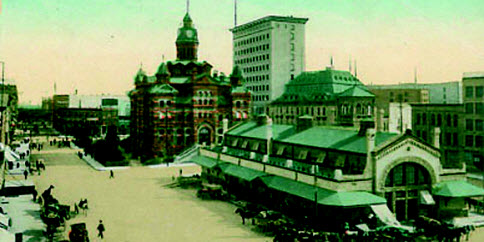by Bruce Cherney (part 2)
When the city brought the Ross property on June 7, 1875, the deed contained a provision that prevented the land being used for any other purpose than civic buildings, such as a new city hall as proposed in 1913. The property was sold by Jemima Ross, the widow of William Ross, William R. Ross and his wife, also named Jemima, and Margaret Ross to the city for $600. In effect, it was a donation to the city, since lots in the area were then being sold for $50 to $150 per foot of frontage.
The critical condition of the sale for such a very nominal fee was: “But provided always and it is the true intent and meaning of these presents that if the said parties of the third part do not within two years from the first day of May now last past erect on said lands and premises hereby conveyed a suitable Market House (the first city-owned market was built in 1876 behind the new city hall, which formally opened in the same year) or should the said parties at any time hereafter use the said lands and premises for any other purpose and uses of the Corporation then the said lands and premises and every part hereof shall immediately revert to and again become the property of the said parties of the first part, their heirs and assigns as if these presents had never been executed.”
The transaction was made in the presence of Henry Harland, a livery stable keeper, who for some unexplained reason didn’t sign the document as its witness. Another problem was that the deed wasn’t registered until May 1885, and there was no affidavit of execution attached, so it was rejected.
Fortunately, Harland was still alive and an affidavit was obtained from him on May 23, 1885, and it was then registered as Instrument No. 43363.
The city didn’t obtain Torrens title No. 995688 to the property until many years later, but this title was still “subject to the covenant respecting a reversionary interest in said lands set in a deed registered in the said office under the Old System as No. 43363.”
When interviewed by a Winnipeg Tribune reporter on March 7, 1913, A.H. Oakes, the president of the Winnipeg Real Estate Exchange (today’s WinnipegREALTORS®), objected to the planned new city hall.
“My personal view is this, and it is the view of the exchange. It is folly to put $3,000,000 in a city hall when we require so many blocks of pavement, so many miles of water mains and sewers and a good water supply.”
Oakes’ opinions were shared by other businessmen outside the real estate industry, who claimed the money could be used to provide essential services the city urgently required.
The opponents need not have worried, since the plan for a new city hall was doomed while it was being discussed. In 1913, the city and nation were caught up in a severe recession, and then came the First World War, the Great Depression and the Second World War, which all diverted attention from the movement for a new city hall.
It wouldn’t be until the late 1940s and the end of the Second World War that a scheme to build a new city hall was resurrected, although it didn’t begin in earnest until the 1950s, when it became obvious that the existing city hall was in a deplorable state of deterioration.
Engineering reports indicated the walls were crumbling, the roof leaked, the flooring was rotten, and the spectator’s gallery had no visible means of support (Winnipeg: Where the West Begins, An Illustrated History, by Eric Wells).
“The only way the building could have been perserved was to fill it from top to bottom with solid concrete — in which case it probably would have sunk down into the ancient creek bed beneath. And with the building no longer used as a city hall, the entire site would have reverted to its original owners,” wrote Wells.
“Hardly a week goes by without the subject of a new city hall being tossed about among aldermen,” wrote Michael Best in his November 21, 1953, Winnipeg Free Press column, Your City’s Business.
“It (existing city hall) was examined by city engineering department two years ago, and W.D. Hurst, city engineer, came out with a report that it stood to be practically destroyed in a violent windstorm.
“Aldermen were told that continued use of the building would be at considerable risk.”
(Next week: part 3)



